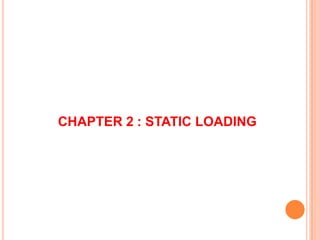
Cd chap 2 - static loading
- 1. CHAPTER 2 : STATIC LOADING
- 2. 2.1 STRESS DISTRIBUTION IN BASIC MACHINE COMPONENTS 1. Rod Critical point (in general): Any point Critical point (specifically): At stress cncentrated points
- 3. 2.1 STRESS DISTRIBUTION IN BASIC MACHINE COMPONENTS Stress at stress concentrated points
- 4. 2.1 STRESS DISTRIBUTION IN BASIC MACHINE COMPONENTS Shear stress in a ‘rod’ (pin, bolt and rivet) Shear stress (ave) = P/A
- 5. 2.1 STRESS DISTRIBUTION IN BASIC MACHINE COMPONENTS Bearing stress in a ‘rod’ (pin, bolt and rivet)
- 6. 2.1 STRESS DISTRIBUTION IN BASIC MACHINE COMPONENTS 2. Beam a. Normal stress b. Transverse shear stress c. Deflection
- 7. 2.1 STRESS DISTRIBUTION IN BASIC MACHINE COMPONENTS Normal stress: Along beam direction Maximum at the top or at the bottom x My I
- 8. 2.1 STRESS DISTRIBUTION IN BASIC MACHINE COMPONENTS (for rectangular beam) • Shear Stress
- 9. 2.1 STRESS DISTRIBUTION IN BASIC MACHINE COMPONENTS
- 10. 2.1 STRESS DISTRIBUTION IN BASIC MACHINE COMPONENTS Critical points: In beams actually, we design for normal stress and shear stress separately. x x xy
- 11. 2.1 STRESS DISTRIBUTION IN BASIC MACHINE COMPONENTS Deflection Assuming linear in material and geometry, P1 x y w dx 2 2 dx yd EIM
- 12. 2.1 STRESS DISTRIBUTION IN BASIC MACHINE COMPONENTS Design of beams Prismatic design: Design for normal stress Sreqd = Required section modulus For long beam. Design for shear stress For short beam with concentrated load Especially for wood beam Fully stressed beam design
- 13. 2.1 STRESS DISTRIBUTION IN BASIC MACHINE COMPONENTS T L GJ TL J T 3. Shaft
- 14. 2.1 STRESS DISTRIBUTION IN BASIC MACHINE COMPONENTS 4. Thin Cylinder
- 15. 2.1 STRESS DISTRIBUTION IN BASIC MACHINE COMPONENTS 5. Thick Cylinder P2 P1 R2 R1
- 16. 2.1 STRESS DISTRIBUTION IN BASIC MACHINE COMPONENTS Critical Points: Inner points: r = R1 Highest maximum shear stress r H R
- 17. 2.2 MATERIAL PROPERTIES Basic material properties: Physical: Density Mechanical: Young’s modulus Shear modulus Yield strength UTS Elongation at break Reduction of area Poisson’s ratio Toughness: modulus of toughness, modulus of resilience Hardness (Brinnel, Rockwell, Vickers) Impact strength (Izod, Charpy) Test: Tensile test Hardness test Impact test
- 18. 2.2 MATERIAL PROPERTIES Tensile test
- 19. 2.2 MATERIAL PROPERTIES Standard codes 1. Society of Automotive Engineers (SAE) 2. British Standards (BS) 3. European standards – (EN) 4. ASTM (UNS) 5. Japanese Industrial Standards (JIS) 6. Germany steel grades (DIN) 7. China steel grades (GB)
- 20. 2.2 MATERIAL PROPERTIES Determine the alloy content, properties, applications and its code number. 1. Cast Iron 2. Carbon Steel & Alloys 3. Stainless Steel & Alloys 4. Aluminum & Alloys 5. Magnesium & Alloys 6. Copper &Alloys 7. Titanium & Alloys 8. Zircanium & Alloys 9. Nickel & Alloys 10. Zinc & Alloys
- 21. 2.3 FAILURE THEORY To develop FS of the design Static failure theory Tresca’s theory von Misses’s theory
- 22. 2.3 FAILURE THEORY 1 1.25 - 1.5 for exceptionally reliable materials used under controllable conditions and subjected to loads and stresses that can be determined with certainty - used almost invariably where low weight is a particularly important consideration 2 1.5 - 2 for well-known materials under reasonably constant environmental conditions, subjected to loads and stresses that can be determined readily. 3 2 - 2.5 for average materials operated in ordinary environments and subjected to loads and stresses that can be determined. 4 2.5 - 3 for less tried materials or for brittle materials under average conditions of environment, load and stress. 5 3-4 for untried materials used under average conditions of environment, load and stress. 6 3-4 should also be used with better-known materials that are to be used in uncertain environments or subject to uncertain stresses. 7 Repeated loads : the factors established in items 1 to 6 are acceptable but must be applied to the endurance limit (ie. a fatigue strength ) rather than to the yield strength of the material. 8 Impact forces : the factors given in items 3 to 6 are acceptable, but an impact factor (the above dynamic magnification factor ) should be included. 9 Brittle materials : where the ultimate strength is used as the theoretical maximum, the factors presented in items 1 to 6 should be approximately doubled. 10 Where higher factors might appear desirable, a more thorough analysis of the problem should be undertaken before deciding on their use. based on yield strength - according to Juvinall & Marshek op cit.
